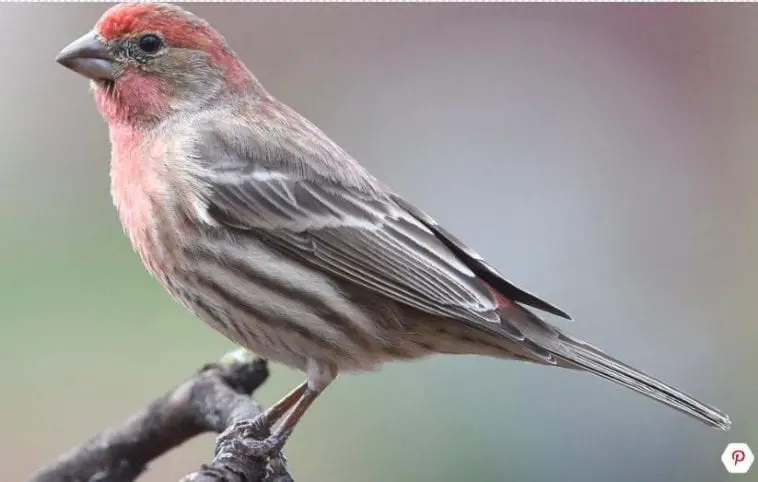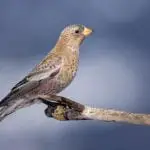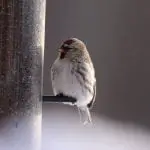Scientific Facts
| Common Name: | House Finch |
| Scientific Name: | Carpodacus mexicanus |
| Life Span: | More than 11 years (in captivity) |
| Size: | 6 inches |
| Habitat: | Grasslands, deserts, open forests, deserts, edges of the ponds and rivers, and urban areas |
| Country of Origin: | United States |
Physical Description

House finches are small birds. In most cases, they measure more than 5 inches long, and many of them weigh less than one ounce. The shape of their bodies is pretty similar to purple and other finches. They also have short and thick beaks.
Both male and female house finches have light brown feathers and dark brown and white mottling. On the other hand, the males often have red or pinkish spots on their chests up to their heads.
House finches are small-bodied birds. Though their beaks are short, they look fairly big. Their heads are flat and long. Their wings are short, but their tails are long that add up to their overall length. Finches are known for their noticeably notched tails. However, the tails of house finches have a shallow notch.
Adult male house finches are pinkish-red around their face up to their upper chest. Their backs are streaky brown, just like their bellies and tails. Their red rump appears when these birds are in flight. For females, they are not red. Instead, their plumage is graying brown with blurry and thick streaks. Their faces are indistinctly marked.
Geographic Variation
House finches seem to have up to 12 described subspecies. 4 of them exist in North America, particularly in the north of Mexico. Clinical variation in which populations have come together and the individual difference and effects of their diet on the coloration of their feathers complicate the distinction of all subspecies.
Frontalis is the most widespread subspecies across the US. They have an orangey-red to yellowish feathers on their breasts while having less distinct streaks on their bellies. The clementis from the Channel Islands in California and the potosinus originating in Central Texas are bright red with darker-colored streaks on their white bellies.
Similar Species
Recognizing the male and female house finches from other finches demands care. The male house finches differ from the male purple finches, not just with their smaller and curved beaks, but they lack also the distinct eyebrow. Instead, they have an auricular patch and a brown cap. They also have more streaks on their bellies.
Also, they differ from the male Cassin’s finches with their brown cap, eyebrows, and curved beaks. The male Cassin’s finches have pink cheeks and pink feathers on their backs while the female and juvenile male Cassin’s have crisp and much finer streaks on their bellies. The male common rosefinches are rosy pink in plumage and lack the distinct streaking on their bellies.
The female house finches don’t have any markings on their faces compared to Cassin’s and purple that both have distinct eyebrows. They have brownish underparts and blurry streaks underneath. Also, the female house finches have smaller and more curved beaks. They may look similar to female common rosefinches, but they have duller coloration and less distinct streaks.
Regional Differences
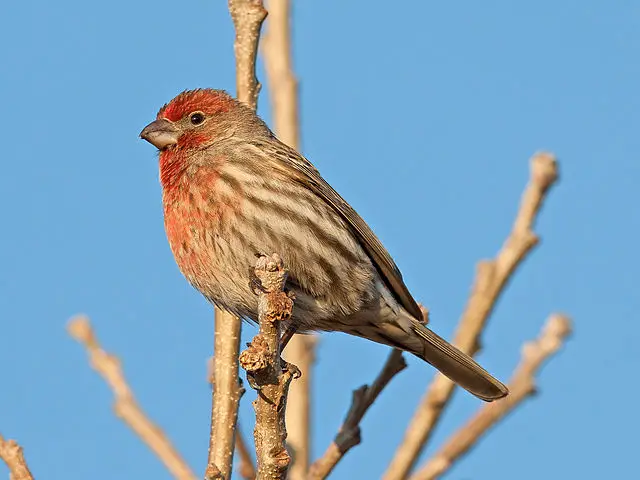
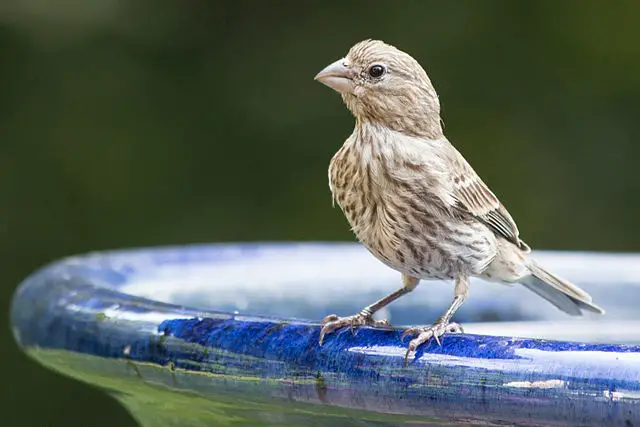
House finches, especially the males, may look too different from each other. That is mainly because of the differences in their diets, not due to regional differences. Although the house finches originating in North America are not related to some species of birds found in Long Island, still they don’t have big differences when it comes to shaping, size, and coloration.
Migration Pattern
House finches don’t migrate in general. However, they may become nomadic in searching for food, especially in winter, when most sources of food may diminish.
Habitat
These little birds are so adaptable. They often live in those areas where other species don’t prefer to live. They live in grasslands, deserts, open forests, and edges of the ponds and rivers. They also prefer to live in urban areas.
Many of these birds in the east of North America have survived by living near the houses. These urban occupants prefer to stay in the backyards, cities, parks, farms, and suburban areas. In terms of their natural range, these birds settle for more traditional and less urban areas.
Distribution
With human interaction, the house finches have chosen to live across North America. The range of these birds extends from the south of Canada to the United States and a greater part of Mexico. They live on most of the bigger islands of Hawaii.
Originally, house finches have lived primarily in Oregon, California, Idaho, Mexico, New Mexico, and other nearby states. Across their range, these birds tend to be year-round residents.
Life Span
In the wild, house finches live for more than 11 years, but many of them probably die earlier than that. In captivity, they may live for 15 years or longer with proper care, nutrition, and handling.
Behavior
House finches are somewhat social. They live in flocks of different sizes. Outside the breeding period, the flocks of these birds may comprise of hundreds of birds. Flocks will roost together and will eventually separate into smaller clusters to hunt and feed themselves.
These birds spend their days in hopping around the ground and through the plants in searching for berries, seeds, and fruits. As for the breeding period starts, pairs will form and break off from the flocks to breed. Male house finches court and attract the females by bringing them food.
Voice and Calls

The call of male house finches is mostly a whistled wheat. The song of this bird is high-pitched and lively that consists of varying 3-note phrases which typically end in the nasal wheeer.
Perception and Communication
House finches make use of visual cues and vocalizations in communicating. Their calls consist of sounds like “weet” and “kweat.” They are making these sounds to stay in contact with their mates. The songs of house finches are described by the blissful warble, but this song is not as rich as the beautiful song of the purple finches.
Males often sing. They sing, especially when their mates are busy constructing the nest. They will perch and sing while watching over the females, protecting them from predators or other males. Male house finches also sing during feeding, incubation, and nestling period. Females will also sing during feeding, courtship, and mating.
Aside from singing, house finches are also using visual cues in communicating with others. These involve plumage coloration and posture changes.
Diet
House finches are herbivorous, so they eat nothing else aside from plants. On rare occasions, these birds feast on insect larvae and small invertebrates. They do only when their main type of food is scarce. In most cases, house finches eat seeds, fruits, budding flowers, and berries.
Some of the seeds they love are mustard, poison oak, cactus, sunflower, thistle, and millet. Also, they eat cherries, pears, peaches, strawberries, figs, blackberries, apricots, and many more.
Feeding Behavior
House finches forage on the ground as they perch in weeds and shrubs and trees. However, they tend to forage in flocks during the nesting period. They will also visit the feeders to eat seeds, particularly the sunflower seeds. Also, they will fly to hummingbird feeders for the sugar-water.
Predation
Adult house finches are victims of bigger mammals like domestic cats, sharp-shinned hawks, and cooper’s hawks. Nest predators like blue jays, common crows, common grackles, fox squirrels, eastern chipmunks, skunks, rats, snakes, domestic cats, and raccoons. House finches avoid the predators mainly through vigilance. Feeding them in groups is a good idea as they can help each other when predators are around.
House Finches and Their Roles in the Ecosystem
House finches are crucial seed dispersers and predators. Likewise, house finches give a source of food for snakes and birds of prey.
House Finches and Their Positive and Negative Importance for People
House finches are welcome visitors to backyards with bird feeders. They give entertainment and pleasure to people who listen to their songs and presence that signifies the advent of spring. House finches may cause damages to some plants like orchards, apricots, peaches, cherries, plums, and nectarines.
Reproduction
House finches are monogamous. They mate to just one partner throughout the breeding period. A pair of house finches may produce multiple clutches of hatchlings for the entire season. Females construct the nest and incubate the eggs. Every clutch will contain around 4 eggs. The incubation period will last for around 2 weeks.
The breeding period lasts between March and August. A pair might lay as much as 6 clutches throughout the breeding time. However, they produce no more than 3 clutches. The female constructs the nests that are shallow cups made of hair, grasses, and other fibers.
Nests are made of sagebrush, cactuses, salt brush, mountain mahogany, tree cavities, on tree branches, buildings, and in the bird boxes. The female house finches will then lay 3 up to 6 greenish-white or bluish eggs with black spots near their big tip.
The eggs weigh around 2.4 grams and will take 12-17 days to hatch. On average, the eggs take 13 to 14 days to hatch. Both male and female house finches will feed their hatchlings and eliminate the lingering fecal sacs inside the nest. Adults eat these fecal sacs.
Sooner, the hatchlings will be strong and ready to leave the nest. They will fledge in the next 12 to 19 days. The males will continue feeding the young birds for an infinite period or might be no longer than the incubation time. The females will be busy building a new nest where they will be laying the second clutch of eggs.
When the juveniles become independent, they will form big flocks with their fellow birds and congregate at the sources of food. They will be ready to breed in the upcoming spring.
Only the females incubate the eggs. The males will also be there but only to feed the females. They won’t take care of the eggs. They don’t help the females in incubating the eggs. The females will take care of the eggs until they hatch. The males will help them only in feeding the young.
Nesting
Pairs may start forming flocks during winter. Some pairs might remain together throughout the year. During the breeding period, males perform flight-song display and sing while they flutter up with sluggish wingbeats and glide down. Males feed the female during courtship until incubation. Males will sing anytime they want to while females sing during the spring.
House finches will nest in various coniferous and deciduous trees and on rock ledges and cactus. They nest in and or in buildings by using sites such as ledges, vents, ivy, hanging planters, and street lamps. Occasionally, the house finches use the abandoned nests of some other birds.
The nest of house finches is made of leaves, fine stems, rootlets, string, thin twigs, feathers, and wool, but finer materials for linings. In general, the width of the nest measures 3” to 7” with the inner cup 1” to 3” across and up to 2” deep. The nestling period for house finches lasts for 12 to 19 days.
Eggs
Every clutch contains 4 to 5 eggs in most cases. In some cases, a clutch contains 2 to 6 eggs. The eggs are pale blue with lavender and black dots seen mostly on the bigger end of the eggs. Females could have up to 3 broods every year. The eggs of house finches measure 0.6 to 0.8 inches long and 0.5 to 0.6 inches wide.
Babies and Juveniles
Both parents will feed the hatchlings. Juveniles will leave the nest around 12 to 15 days after they hatch. Females will have as much as 3 broods every year or sometimes more.
The parents must be there to help the hatchlings grow and learn how to become independent. When the parent dies or can’t care for the babies, human intervention is important. Although the babies are weak, you may succeed in raising them with your bare hands until you’re sure they can start living with other finches.
Look for a cage or box which will protect the babies and give quick access for feeding and care. Make sure the babies can’t escape before you can put them in the cage with the adult finches.
Be sure the nest is in the corner of your pet’s enclosure or box. It could be made of flannel fabric or fleece and must have sides that are high enough. This way, the babies can’t roll out of this. Wrap the area for the babies with a sheet of pleated paper towel.
Put the cage with the baby finches where heat could be controlled. The babies should not get so hot or so cold. The temperature must be planned between 88 to 92 degrees Fahrenheit. A heat lamp on top of the enclosure works well as the heating pad underneath it.
Place a thermometer inside the enclosure between the nest and the enclosure’s wall. You have to constantly check the cage, especially the heat level until the ideal temperature has been achieved.
Buy a ready-made seed mixture from the pet supply and feed supply stores. Don’t forget to add one bottle of Pedialyte. Come up with a schedule of feeding the babies around the clock in timed intervals.
Watch the crop in the necks of the babies as it will tell when the babies are hungry. When the crop is puffed out or flat, this means the babies are hungry and require food. Mix the ready-made seeds with Pedialyte to make it watery.
Feed the baby house finches by filling the eyedroppers with ready-made seed mixes. A syringe used in administering medicines to infants will work as well. When you feed the baby house finches, give them only some and let them take the seeds at their own pace. Never pressure them to eat.
Keep in mind that baby house finches don’t breathe when they eat. That’s why it is so important to feed them in small amounts, allowing them to gasp some air in between. Also, do not attempt to overfeed the babies as it may lead them to death.
Change the paper towels in the nest of baby finches before putting them back into it. They may fall asleep quickly. Crash the tiny bugs and occasionally mix them with seed mixture and enough water after 2 weeks of feeding them with pure seed mixture.
Keep feeding the baby house finches at regular intervals. The bugs are excellent sources of protein, keeping your pets healthy and happy. This time, consider giving them a few drops of water. Don’t mix the water with food. You may also continue with Pedialyte.
Change the manmade bird nest inside the box with the real house finch nest, which you can get from pet stores. Put it inside the cage. The babies are strong enough at this point. Therefore, they can easily stick out their heads outside the nest and inform their owners that they are hungry.
Regardless of the type of directions, you may follow in raising baby house finches, their chances to survive will still be minimal when they are newly hatched. Just remember that even when the babies do not survive, your loving hands tried to save them.
Give crushed bird seeds in the bowl, which attaches to the interior of your pets’ cage together with the water container. In 3 weeks, the babies are already big and agile enough to jump from the opening of their nest to the bowl. They are now actively watering and feeding themselves. It is okay to leave the babies inside the cage for the rest of their lives.
Put the baby finches into the cage mixed with other finches when they are already 5 weeks old. At that period, they are old enough and will never be picked on by the adults. Do not discard the cage so that you can easily return them to that cage when problems arise, and you have to move them back to that cage. Feel free to introduce other finches to the babies inside their cage.
Furthermore, you should keep the bedding of the babies clean. Replace the used paper towels frequently or when needed. Keep the environment as silent as possible. Don’t make loud noises as the babies will startle easily. Keep the babies and their cage in a safe area that is safe from kids and other pets.
Don’t underheat or overheat the juveniles and never force them to eat. All these conditions can lead to the death of the babies.
Conservation
House finches exist across their common range. There are about 21,000,000 baby finches across the world. This species does not receive protection from the concerned agencies except by the coverage of the Migratory Bird Treaty Act of the United States. This law prohibits illegal capturing and keeping house finches. It requires the interested bird keepers to get a permit to care for these birds.
House Finches as Pets
Humans attempted to test this species in the 1980s. Their experiment ended in spreading the species all over the eastern of the United States. House finches are great songbirds. You can turn them into tamed and sociable pets with proper handling and frequent interaction between you and these birds.
Availability – Where to Get One?
If you want to take care of house finches, then the first thing you should do is seek a permit and look for adoption programs designed for house finches. Do your homework today and find out how you can become a legal caretaker for these beautiful songbirds.
How to Care for House Finches?
House finches are considered common birds in the United States. Their care requirements are just like the given care necessities for other types of finches. They will be happy if kept in a big enclosure that gives them more space to fly and play. Aviaries will also be great for house finches.
Their enclosure should have more perches and low shrubs where they can feed on or hide in. Like other finches, they grow on a seed-based diet with more supplemental berries and fruits.
Housing
The cage suitable for house finches is known as an aviary. Providing your pets with the best aviary is so important. Your first consideration in choosing a perfect aviary for them is the space. The minimum space for a pair of house finches should be at least 32 inches in width, 22 inches in depth, and 36 inches in height.
Enclosures of this size will give house finches with enough room for stretching their wings. Likewise, it will maintain ample individual space for each personal territory. A lot of finch keepers settle for the enclosure that measures 5 feet in length, 5 feet in width, and 2 feet in depth. A cage of this size will be enough for keeping 4 to 6 birds.
Keep your pets in good condition by providing them more space. It is a general rule to follow in taking care of birds of any kind. Despite their size, these birds are active and will demand a sizable housing that will lead them to a happy and healthy life. Maintaining the house finches and their housing is quite affordable compared to bigger birds. However, keep in mind that the job will demand more of your time and attention.
It is so important to learn and understand the housing requirements of the house finches. Be sure that you can provide all of them to the birds before getting your first pair. Preferably, the cage must be purchased and put in a good location ahead of time because when you get the birds and put them inside the cage, you cannot take them out of that cage again.
Maintenance
In keeping house finches healthy and happy, you should:
- Provide them with sufficient fresh and drinkable water every day. It should be pure water. No antibiotics, disinfectants, and vitamins added to the water.
- Be sure there’s ample supply of fresh food. Sometimes, a dish seems jam-packed with seeds, but in reality, it just contains empty hulls of seeds.
- Clean the housing when it gets dirty. Clean the perches, the bottom of the cage, dishes, and the nest.
- Sterilize the cage once every month with a completely diluted bleach solution and other ideal disinfecting solutions.
- Provide them with moist foods and make sure you remove the uneaten ones after around 4 hours. This will help prevent your pets from consuming rotten or spoiled foods.
- Check the droppings of your birds. Observe them for color, amount, and consistency. Do these things for urine, urates, and feces. Take note of any significant changes that you may notice in them.
- Avoid putting the birds in areas with loud noises, heavy traffic, or anything else. A noisy environment is a big stressor for house finches. When they get stressed, these birds are more susceptible to different health-related issues.
- Don’t put the cage of your house finches near the hooked-bill birds like parrots. These birds are noisy and able to hurt and injure the finches.
- Keep your pets safe as well from other pets you have at home like dogs, snakes, and cats.
- Always give them the chance to have fun in the water. House finches love to bathe, so put a wide and shallow water dish in their cage. Be sure the water is clean, as they may often drink out of the water dish.
- Check their housing for any indications of bleeding. Look for something like blood drops on the perches. Also, inspect the birds for feather loss, which is not due to molting.
- Observe the birds every day to ensure bickering is always in control, and no finch looks sick.
- Be sure the birds receive proper and adequate lighting.
- House finches like to fly. They climb but don’t do it often. Therefore, their cage should be taller. They will love the cage if it has more space above them.
- Every house finch must have around 20 centimeters of space of personal space. If not, the birds may feel confined, which can be stressful for them. When buying a cage for them, go for a bigger one.
- Don’t put the cage in rooms with fluctuating or changing temperatures because of coolers or AC. Also, leaving them exposed to air perfumes or fresheners is not good for finches.
- Keep the cage protected. It should not be accessible to other domestic animals like dogs and cats.
- Lifting, hanging, and changing the position of the cage may stress your timid birds. Therefore, avoid moving the cage unless you need to. If you have to, then be sure you’re going to move it for good just once.
- Keep the birds away from noisy places such as your art room, where you often entertain your guests.
- When you take them home, observe the birds and make sure they look and feel comfortable. If they are stressed, these birds may portray self-destructive behaviors such as feather-plucking.
Common Health Issues Among the House Finches
#1. Stress
Stress is the leading cause of feather loss in house finches. Are the other finches harass your new pets? If that happens, then you have to segregate the bad guys from the newbies. The rivalry may arise during the mating season.
Malnutrition can also cause stress to house finches. The recommendations for this case will improve their diet. Feed them with a quality combination of egg food like crushed boiled eggs with shells, dry finch mix, grated carrots, herbs, and greens like cabbage or cucumber. Also, you must increase their exposure to sunlight, which is beneficial for the growing bodies of young house finches.
#2. Parasites
If most of your birds are losing their feathers, this may indicate a possible parasitic infection that should be treated as soon as possible.
#3. Breeding or Hormonal Problems
Feather loss could also be due to hormonal issues in hens and breeding birds out of the mating season.
Houses Finches and Human Interaction
House finches and humans interact somewhat frequently, particularly in the east of their range. People are setting bird feeders at their backyards to encourage these birds to land and stay there for a while. House finches take advantage of the feeders and feed on them. However, farmers hate these birds as they damage the crops, especially the fruits.
Nonetheless, these tiny birds have strong populations. They live across their wide range in North America. The IUCN enlisted this species like the least concern. Researchers estimated their total populations are reaching more than 20 million.
Fun Facts About House Finches
- Like the flamingo, blue-footed booby, and roseate spoonbill, the coloration of house finches comes from their food. When the males consume berries and fruits, the pigments in those fruits become concentrated. The more they eat, the brighter their colors.
- Like the brightly-colored birds, the female house finches prefer their mates depending on the color of their feathers. According to scientists, they believe that the brightly colored males can collect healthy foods more frequently. They pass on this trait to their babies.
- House finches differ slightly in a way they feed their offspring. A lot of omnivorous songbirds eat invertebrates and insects during the mating season. They feed their hatchlings a diet rich in insects.
- House finches are among those songbirds which feed their hatchlings with plants. However, goldfinches feed their hatchlings a seed-based diet.
- Moreover, these tiny birds do not always live across North America. Their range for the past several years was smaller than their range today. In the early 1900s, these birds had lived in the west of the United States to Mexico. People introduced the species to the east of the United States and Hawaii.
FAQs
How long do house finches grow?
House finches grow up to 6 inches long. This is one of the beautiful little birds in the US.
What is the scientific name of house finches?
These birds do not have much difference to their relatives like the purple finch in terms of size and behaviors. Their scientific name is Carpodacus mexicanus.
Can house finches make good pets?
House finches are rarely kept as pets. Taming them is possible, which then turns them into good, calm, and sociable pets.
Are house finches susceptible to aggression?
These birds don’t often show aggressive behaviors. Males tend to show their aggressiveness only during the breeding season.
What do house finches eat?
House finches are herbivores. They may eat insects, but they do it only when they struggle to find their main sources of food.
Do house finches migrate?
House finches are not migratory birds. However, they tend to be nomadic when they are searching for food.
How do house finches communicate with themselves?
Their calls are comprised of high-pitched sounds and varying 3-note phrases that normally end with a nasal “wheeer,” but they may also communicate through postures. They make sounds like “kweat” and “weet.”
Where do house finches originate?
The house finches originate in the United States. Their range exists in North America, reaching Mexico and even Canada.

